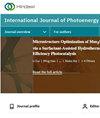Smart Integrated Decentralization Strategies of Solar Power System in Buildings
IF 2.1
4区 工程技术
Q3 CHEMISTRY, PHYSICAL
引用次数: 8
Abstract
This study signifies the need for a smart integrated decentralized solar energy system in Pakistan. Since the outlook of energy is highly dominated by its power sector, policy measures must be adopted to ensure its penetration in the system of any country. After the industrial, the housing sector is the major energy-consuming sector. The goal of this study is to assess energy generation through a smart integrated decentralized solar energy system in the power hub of a commercial area in Taxila, Pakistan. Model development involves a hypothetical model built on LabVIEW which allows the user interface a way to intermingle with the source code. It permits the user to the transformation of the values sent to the source code and sees the information that the source code calculates. The proposed system is a collaborative sharing integrated decentralized solar system that credits sunlight-based energy framework proprietors for the power they add to different buildings due to the collaborative sharing mechanism at Rs.10 per kWh. This low-cost electricity is available at your doorstep that you can share according to the collaborative sharing basis that will not range any certain variable. Results from the literature describe that 30% of the cost associated with the commercial price of electricity amounts to distribution cost. This system of the utilization of energy would be applied at a local level to achieve the maximum power generation from solar panels through blockchain use of solar systems, especially in regions that have no entrance to traditional power with little odds of getting associated in the next 5-10 years.建筑太阳能系统的智能集成分散策略
这项研究表明,巴基斯坦需要一个智能集成的分散式太阳能系统。由于能源的前景在很大程度上取决于其电力部门,因此必须采取政策措施以确保其渗透到任何国家的系统中。继工业部门之后,住房部门是主要的能源消耗部门。本研究的目标是评估巴基斯坦塔克西拉商业区电力中心的智能集成分散式太阳能系统的发电量。模型开发涉及建立在LabVIEW上的假设模型,该模型允许用户界面与源代码混合。它允许用户对发送到源代码的值进行转换,并查看源代码计算的信息。拟议的系统是一个协作共享集成分散式太阳能系统,由于协作共享机制,以每千瓦时10卢比的价格将基于太阳能的能源框架所有者的电力归功于他们为不同建筑物增加的电力。这种低成本的电力就在你家门口,你可以根据协作共享的基础来共享,而不涉及任何特定的变量。文献结果表明,与电力商业价格相关的成本中有30%为配电成本。这种能源利用系统将在地方一级应用,通过大量使用太阳能系统实现太阳能电池板的最大发电量,特别是在没有传统电力入口的地区,在未来5-10年内几乎没有机会与之联系。
本文章由计算机程序翻译,如有差异,请以英文原文为准。
求助全文
约1分钟内获得全文
求助全文
来源期刊
CiteScore
6.00
自引率
3.10%
发文量
128
审稿时长
3.6 months
期刊介绍:
International Journal of Photoenergy is a peer-reviewed, open access journal that publishes original research articles as well as review articles in all areas of photoenergy. The journal consolidates research activities in photochemistry and solar energy utilization into a single and unique forum for discussing and sharing knowledge.
The journal covers the following topics and applications:
- Photocatalysis
- Photostability and Toxicity of Drugs and UV-Photoprotection
- Solar Energy
- Artificial Light Harvesting Systems
- Photomedicine
- Photo Nanosystems
- Nano Tools for Solar Energy and Photochemistry
- Solar Chemistry
- Photochromism
- Organic Light-Emitting Diodes
- PV Systems
- Nano Structured Solar Cells

 求助内容:
求助内容: 应助结果提醒方式:
应助结果提醒方式:


